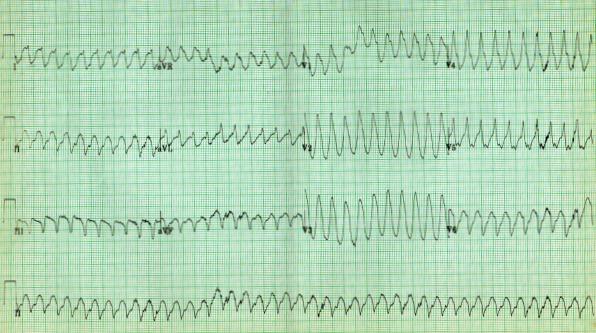Ventricular tachycardia pathophysiology: Difference between revisions
m (Robot: Automated text replacement (-{{SIB}} +, -{{EH}} +, -{{EJ}} +, -{{Editor Help}} +, -{{Editor Join}} +)) |
No edit summary |
||
| Line 1: | Line 1: | ||
{{Ventricular tachycardia}} | {{Ventricular tachycardia}} | ||
{{CMG}} | {{CMG}}; '''Associate Editor-In-Chief:''' {{CZ}} | ||
==Overview== | |||
== | |||
The morphology of the tachycardia depends on its cause. | The morphology of the tachycardia depends on its cause. | ||
| Line 20: | Line 16: | ||
[[Category: Cardiology]] | [[Category: Cardiology]] | ||
[[Category:Electrophysiology]] | |||
{{WH}} | {{WH}} | ||
{{WS}} | {{WS}} | ||
Revision as of 20:42, 3 September 2012
|
Ventricular tachycardia Microchapters |
|
Differentiating Ventricular Tachycardia from other Disorders |
|---|
|
Diagnosis |
|
Treatment |
|
Case Studies |
|
Ventricular tachycardia pathophysiology On the Web |
|
to Hospitals Treating Ventricular tachycardia pathophysiology |
|
Risk calculators and risk factors for Ventricular tachycardia pathophysiology |
Editor-In-Chief: C. Michael Gibson, M.S., M.D. [1]; Associate Editor-In-Chief: Cafer Zorkun, M.D., Ph.D. [2]
Overview
The morphology of the tachycardia depends on its cause.
In monomorphic ventricular tachycardia, the reason all the beats look the same is because the impulse is being generated from either increased automaticity of a single point in either the left or right ventricle, or due to a reentry circuit within the ventricle. The most common cause of monomorphic ventricular tachycardia is damaged or dead (scar) tissue from a previous myocardial infarction (heart attack). This scar cannot conduct electrical activity, so there is a potential circuit around the scar that results in the tachycardia. This is similar to the re-entrant circuits that are the cause of atrial flutter and the re-entrant forms of supraventricular tachycardia. Other rarer congenital causes of monomorphic VT include right ventricular dysplasia, and right and left ventricular outflow tract VT.
Polymorphic ventricular tachycardia, on the other hand, is most commonly caused by abnormalities of ventricular muscle repolarization. The predisposition to this problem usually manifests on the EKG as a prolongation of the QT interval. QT prolongation may be congenital or acquired. Congenital problems include Long QT syndrome and Catecholaminergic polymorphic ventricular tachycardia. Acquired problems are usually related to drug toxicity or electrolyte abnormalities, but can occur as a result of myocardial ischaemia. Class III anti-arrhythmic drugs such as sotalol and amiodarone prolong the QT interval and may in some circumstances be pro-arrhythmic. Other relatively common drugs including some antibiotics and antihistamines may also be a danger, particularly in combination with one another. Problems with blood levels of potassium, magnesium and calcium may also contribute. High dose magnesium is often used as an antidote in cardiac arrest protocols.
